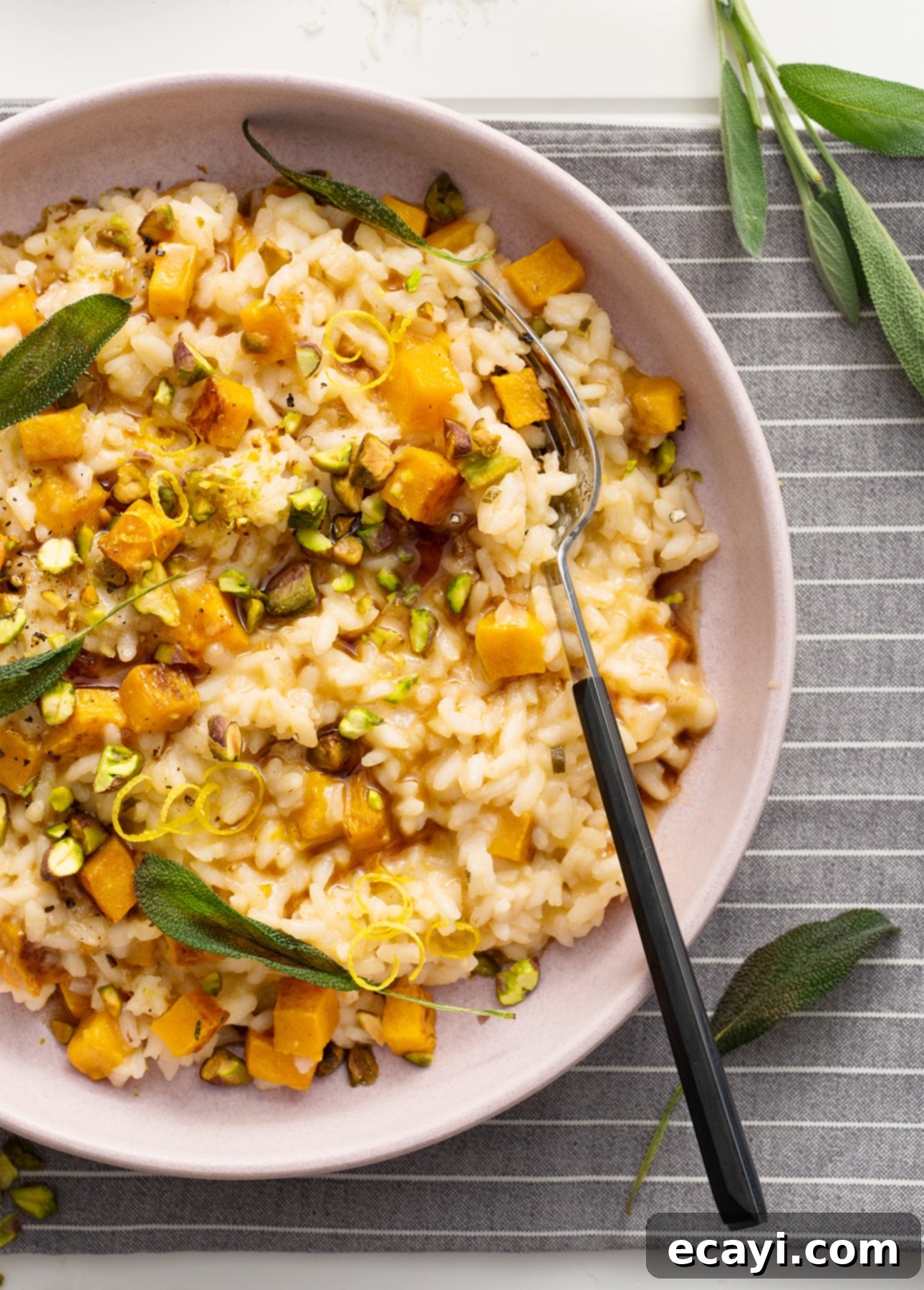Creamy Butternut Squash Risotto with Nutty Brown Butter & Crispy Sage
Indulge in the rich, comforting embrace of this utterly delicious Butternut Squash Risotto, a dish that beautifully marries the beloved Italian flavor trio of brown butter, sweet squash, and aromatic sage. This recipe elevates these classic components into a truly memorable culinary experience, perfect for a cozy night in or an elegant dinner party.
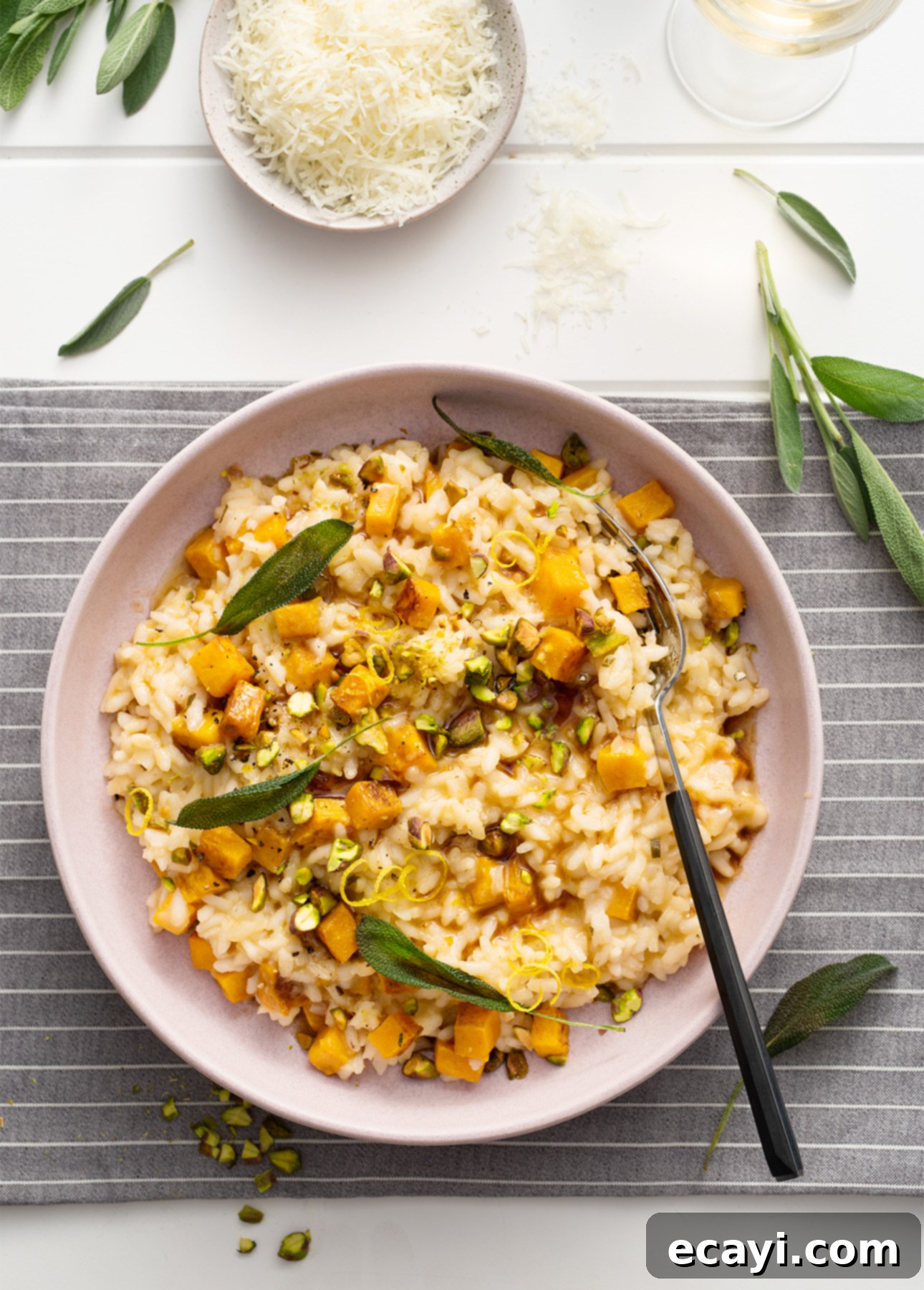
This post contains affiliate links. Full disclosure is at the bottom of the article.
This exquisite butternut squash risotto recipe was initially conceived from my ongoing quest to incorporate the vibrant flavor and unique texture of **pistachios into savory dishes** more frequently. This culinary habit blossomed after an unforgettable journey through Sicily in the summer of 2015. As a global hub for pistachio production, **Sicily masterfully integrates this bright green nut into an astonishing array of culinary contexts, both sweet and savory.** To my delightful surprise, my most cherished gastronomic discoveries during that trip were predominantly savory. I savored pistachios generously sprinkled over diverse dishes, quickly training my palate and eyes to spot them on every menu. I simply couldn’t get enough of the soft, almost creamy bite and subtly sweet, earthy taste they imparted to delicately flavored creations, particularly fresh fish and seafood pasta dishes.
I often declare that risotto holds the top spot as my favorite weeknight meal. In its fundamental form, a classic risotto can be surprisingly quick and straightforward to prepare. However, this particular **Roasted Butternut Squash Risotto** transcends the everyday, making it absolutely perfect for those special evenings when you aim to truly impress your guests, or simply treat yourself to something extraordinary. The symphony of flavors in this dish is nothing short of spectacular, creating a harmonious and deeply satisfying experience. You might already be well-acquainted with the quintessential Italian flavor triad of roasted butternut squash, nutty brown butter, and fragrant sage. But have you ever experienced this magical combination woven into the creamy embrace of a perfectly cooked risotto? Here, the tender, sweet cubes of roasted squash gently melt into the velvety rice, infusing every bite with its comforting essence. The rich brown butter introduces a wonderfully complex, toasted, nutty dimension that elevates the entire dish, while crispy, aromatic fried sage leaves provide a delicate textural contrast and an unforgettable herbal perfume, beautifully complemented by the subtle crunch and unique flavor of pistachios.
While this butternut squash risotto undoubtedly possesses the elegance and complexity to be a show-stopping holiday dish, **there’s no need to wait for a special occasion! Make it on a regular weeknight, too, and transform an ordinary evening into something special.** One of the fantastic aspects of this recipe is its adaptability for meal prep. You can roast the butternut squash in advance, perhaps over the weekend, and then freeze it in convenient portions. This foresight ensures you’re always ready to whip up this exquisite risotto whenever a craving strikes. When pre-roasting, remember to slightly reduce the roasting time by about 5 minutes, as the freezing and subsequent thawing process tends to make vegetables a bit more tender. Thaw your roasted butternut squash either overnight in the refrigerator or by allowing it to sit at room temperature for approximately 30 minutes. Once your risotto is cooked to perfection, simply stir in the prepared butternut squash as directed. Serve this delightful creation in warm, inviting bowls and enjoy it while curled up on the sofa under a soft blanket, perhaps with a fine glass of wine and a captivating movie playing in the background. **For me, this perfectly encapsulates the definition of an ideal night in.**
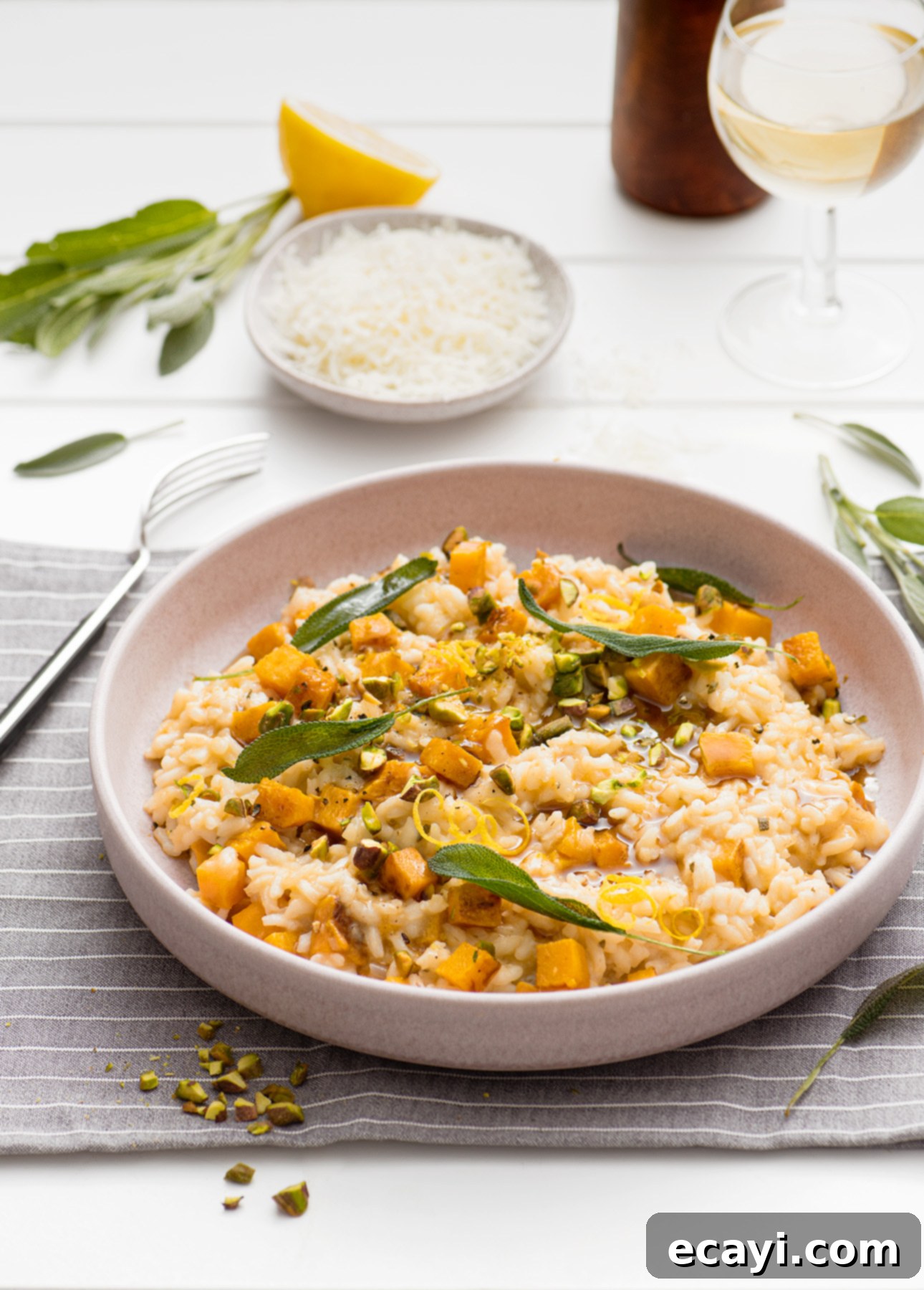
The Art of Making Brown Butter (Beurre Noisette)
The thought of making brown butter might sound like a daunting task, hinting at complex culinary techniques, **but I assure you, it is surprisingly easy and takes just a few precious minutes to achieve.** Once you’ve mastered the simple art of browning butter, you’ll discover a whole new world of flavor and find yourself eager to infuse this deliciously nutty concoction into a vast array of dishes. Its versatility extends far beyond this butternut squash risotto, enhancing everything from delicate French financiers and chewy blondies to countless other irresistible desserts and even savory applications like pan-seared fish or pasta sauces. It truly is a game-changer ingredient that adds depth and sophistication.
To embark on your brown butter journey, begin by placing diced unsalted butter into a small stainless steel saucepan. Opting for a stainless steel pan is key, as its light interior provides a clear backdrop, allowing you to easily monitor the butter’s color as it transforms – a crucial step in knowing precisely when it’s ready. Place the saucepan over medium heat and stir gently until the butter completely melts, creating a shimmering liquid pool. Continue to simmer the melted butter over medium-low heat, occasionally swirling the pot to ensure even cooking. As the water content in the butter evaporates, it will begin to bubble vigorously. This effervescence might, at times, obscure your view of the butter’s true color. When this happens, simply lift the saucepan off the heat for a few seconds and gently swirl it. The bubbles will recede, giving you a clear glimpse of the browning process. If the butter hasn’t yet reached that beautiful golden-brown hue, return it to the heat to continue simmering. Patience and observation are your best tools here.
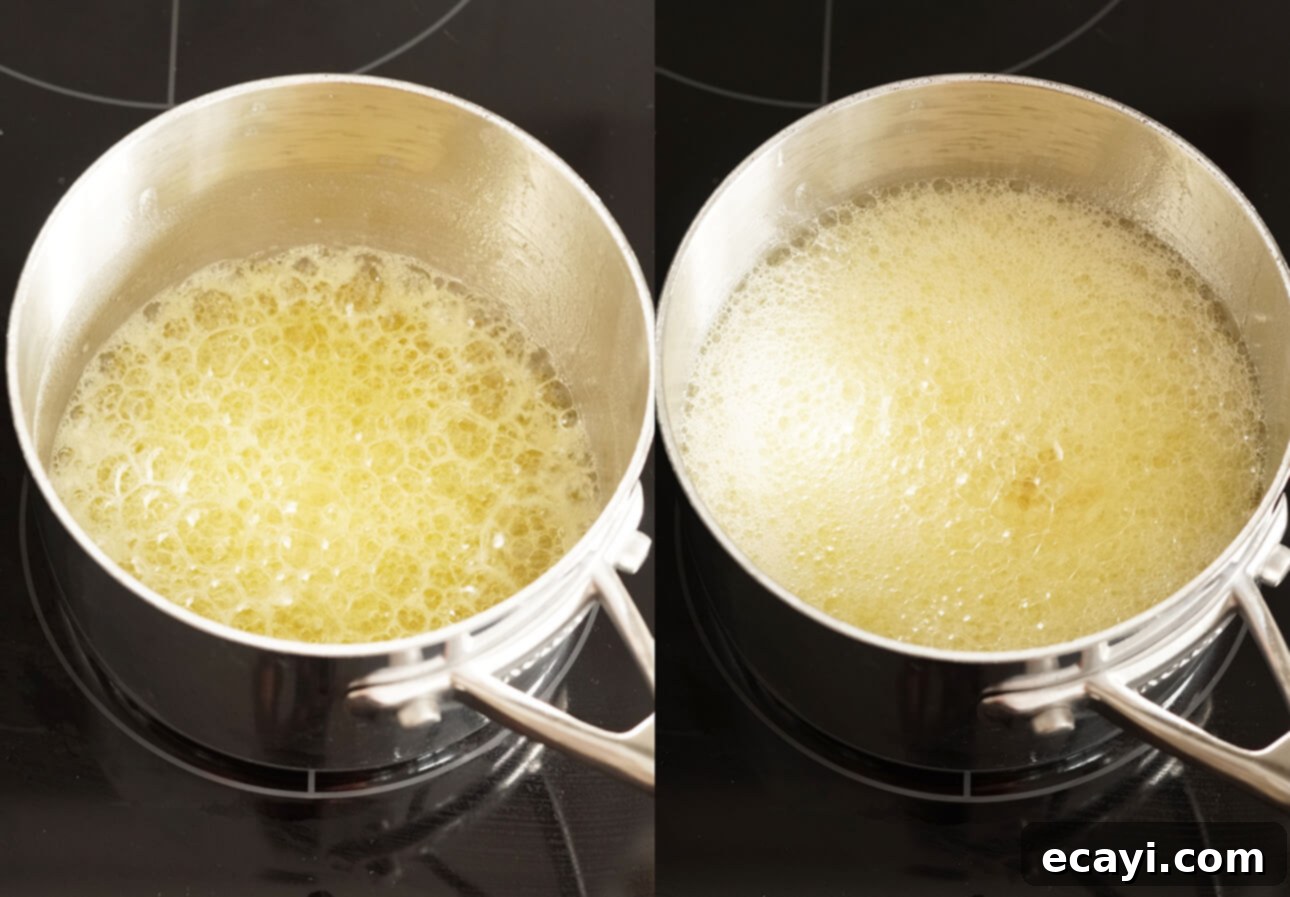
The brown butter reaches its perfect state of readiness when the milk solids, which settle at the bottom of the pot, turn a rich, golden brown color, reminiscent of toasted hazelnuts. Simultaneously, the entire concoction will emit a distinctively delicious, deeply nutty aroma that will fill your kitchen. The moment these signs appear, swiftly remove the butter from the heat to prevent it from burning. Pour the hot brown butter into a small, heatproof bowl and allow it to cool completely. This cooling process helps to set its exquisite flavor and ensures it’s ready for use. The entire browning process, from start to finish, should typically take around 5 minutes, demonstrating just how quick and rewarding this technique can be.

VIDEO: Master the Art of Brown Butter (Beurre Noisette)
Unlocking the secrets to making perfect brown butter, or “beurre noisette,” is simpler than you might imagine. This concise step-by-step video guide will walk you through the entire process, demonstrating just how easy it is to achieve this transformative ingredient. Once mastered, you’ll discover the immense depth of flavor brown butter brings to all your culinary creations, both sweet and savory!
Essential Tips for Crafting the Perfect Butternut Squash Risotto
Achieving a truly outstanding risotto, especially one with such delicate and balanced flavors, relies heavily on a few key considerations. Here are some indispensable tips to ensure your butternut squash risotto is nothing short of perfection:
- Prioritize High-Quality Ingredients for Superior Flavor: As is often the case with many deceptively simple, Italian-inspired dishes, the quality of your base ingredients makes an enormous difference in the final taste and texture. For this butternut squash risotto, I strongly encourage you to source the very best ingredients you can access and afford.
- Broth: Opt for a good quality low-sodium vegetable broth. Even better, if you have homemade vegetable broth on hand, it will undoubtedly impart a softer, more nuanced, and richer flavor profile to your risotto, allowing the delicate squash and nutty butter notes to shine.
- Risotto Rice: The choice of rice is paramount for achieving that signature creamy, yet al dente, risotto texture. Invest in premium risotto rice varieties such as Arborio, Carnaroli, or Vialone Nano. Each possesses specific characteristics that contribute to risotto’s unique consistency; Carnaroli is often considered the “king of rice” for its higher starch content and ability to absorb liquid without becoming mushy, while Arborio is more commonly available and still produces excellent results. Vialone Nano is also a fantastic choice, known for its fine grain and ability to absorb a lot of liquid.
- Cheese: When it comes to the cheese, please, please, please, resist the temptation to use pre-grated parmesan substitutes. For the most authentic and exquisite flavor, **only use freshly grated Pecorino Romano cheese for this recipe.** (See below for an in-depth explanation on why Pecorino Romano is the star here!)
- Embrace Pecorino Romano for a Flavorful Twist: While Parmigiano-Reggiano is the traditional choice for many risotto recipes, for this particular butternut squash rendition, I enthusiastically recommend using Pecorino Romano instead. Pecorino Romano is a hard, salty Italian cheese crafted from sheep’s milk. It boasts a distinctively sharp, slightly tangy, and wonderfully peppery flavor profile, along with a profoundly aromatic quality. This robust character is precisely what’s needed to expertly balance and cut through the milder, naturally sweeter notes of roasted butternut squash and the rich depth of brown butter. Its assertive flavor provides a vibrant counterpoint, preventing the dish from tasting overly sweet or one-dimensional.
- A Note on Saltiness: Be mindful that Pecorino Romano is inherently quite salty – significantly more so than Parmigiano-Reggiano. Therefore, you’ll need to use a slightly smaller quantity to achieve the desired flavor and creaminess without over-salting the dish.
- **Seasoning Wisdom:** Crucially, always **wait until you have thoroughly stirred in the Pecorino Romano cheese into the finished risotto before adding any additional salt to the recipe.** Depending on the specific saltiness of your cheese and broth, you might find that the risotto requires no further seasoning at all. Taste and adjust carefully!
- Effortlessly Scale the Recipe to Suit Your Guest List: Many risotto recipes are notoriously written to serve a fixed number, typically 4 to 6, with ingredient quantities that are challenging to halve or quarter accurately. This common issue has always been a point of frustration for me, as I frequently prepare risotto for just two people. To address this, I’ve thoughtfully developed all my risotto recipes to serve 2 as a base. This convenient starting point means the calculations for scaling up the ingredients to serve 4, 6, or even more guests become incredibly simple and straightforward. **Please note that this butternut squash risotto recipe yields a generous 2-serving portion** – a hearty meal for two. If this dish is part of a more elaborate menu that includes appetizers and side dishes, you could easily stretch it to accommodate 3 servings.
- Elevate Your Risotto with Chef-Inspired Garnishes: This butternut squash risotto is undeniably beautiful and perfectly delicious straight out of the pan. However, if you can spare just a few extra minutes, dedicating them to thoughtful garnishes will effortlessly elevate your dish to professional chef levels, enhancing both its visual appeal and its complex interplay of textures and flavors. Consider topping each individual serving with a selection of fresh, textured ingredients.
- Fried Sage Leaves: These add an irresistible crunch and a concentrated burst of aromatic, earthy flavor.
- Lemon Zest: A finely grated dusting of lemon zest introduces a bright, zesty counterpoint that cuts through the richness and lifts the overall taste.
- Chopped Pistachio Nuts: Beyond their beautiful green hue, pistachios contribute a delightful crunch and a unique, savory nuttiness that complements the brown butter and squash beautifully.
- A Final Drizzle of Brown Butter: A light trickle of that exquisite aromatic brown butter just before serving adds an extra layer of richness and depth, making the flavors sing even more harmoniously.
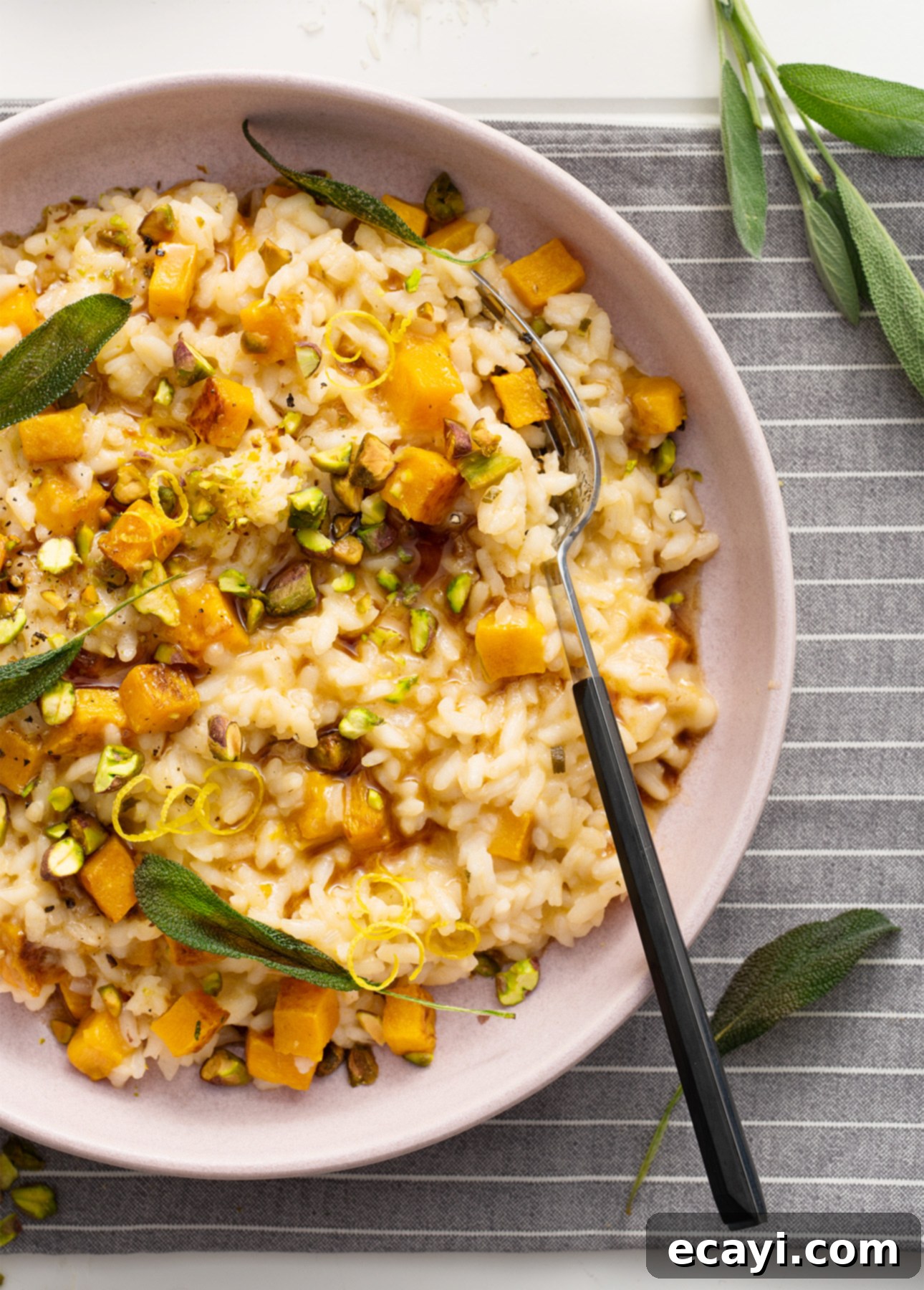
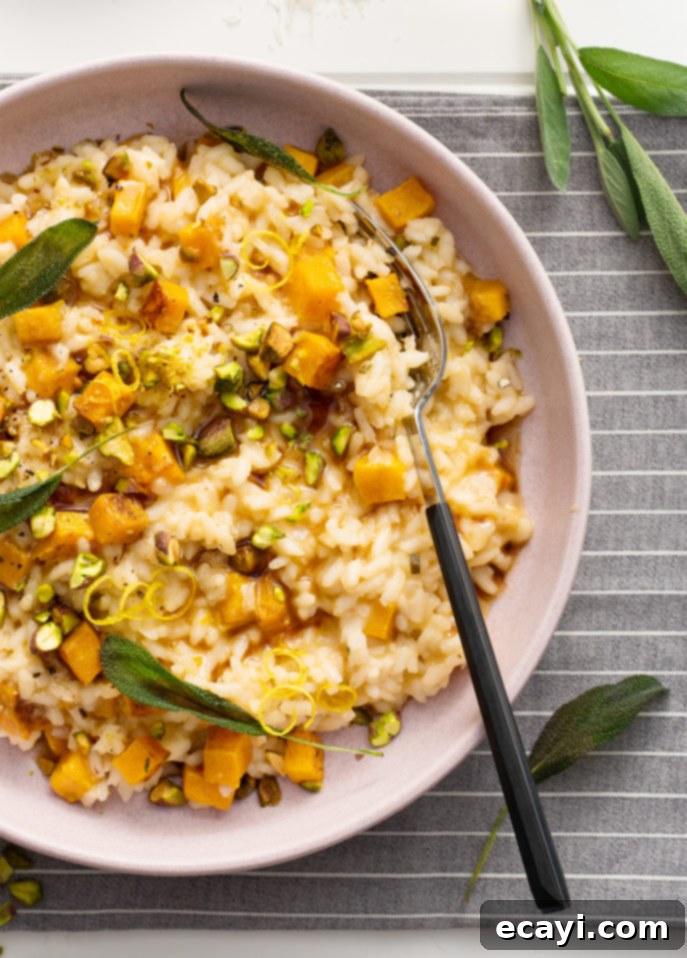
Pin Recipe
Roasted Butternut Squash Risotto with Brown Butter and Sage
40 minutes
40 minutes
1 hour
20 minutes
2
generous servings
Marie Asselin, FoodNouveau.com
Ingredients
Metric
For the Roasted Butternut Squash
- 1 cup ½-inch (1 cm) butternut squash cubes (from about ¼ of a medium squash, see note below for prep instructions)
- 1 tbsp extra-virgin olive oil
- Pinch kosher salt, or fine sea salt to taste
- Freshly ground black pepper
For the Brown Butter
- ¼ cup unsalted butter
For the Crispy Fried Sage Leaves
- 1 tbsp extra-virgin olive oil
- About 6 fresh sage leaves
For the Butternut Squash Risotto
- 3 cups low-sodium vegetable broth
- 2 fresh sage leaves, finely minced
- 1 tbsp extra-virgin olive oil
- 1 shallot, finely minced
- 5 oz risotto rice (such as Arborio, Carnaroli, or Vialone Nano)
- ½ cup dry white wine (like Pinot Grigio or Sauvignon Blanc)
- ½ cup freshly grated Pecorino Romano cheese
- Finely grated zest and juice from ½ a lemon (approximately 1 tsp / 5 ml zest and 2 tbsp / 30 ml juice)
To Serve (Optional Garnishes)
- ¼ cup shelled pistachio nuts, coarsely chopped
- Additional lemon zest, for garnish
- Freshly ground black pepper, for garnish
Instructions
-
Prepare the Roasted Butternut Squash: Begin by preheating your oven to 425°F (210°C). Line a large baking sheet with parchment paper to prevent sticking and make cleanup easier. Spread the butternut squash cubes evenly over the prepared baking sheet, ensuring they are in a single layer for optimal roasting. Drizzle generously with olive oil and season lightly with a pinch of kosher salt and a few grinds of fresh black pepper. Toss the squash cubes gently to ensure they are all evenly coated with the oil and seasonings. Re-spread the cubes back into a single layer on the sheet. Roast for 15 minutes, or until the squash cubes are tender when gently pierced with the tip of a knife. Start checking for tenderness around the 12-minute mark to avoid overcooking them into mush. If you desire a bit of extra color and caramelization, you can briefly broil them for 1-2 minutes, watching closely to prevent burning. Remove the roasted squash from the oven and set aside.
(Meal Prep Tip: You can certainly prepare the roasted butternut squash in advance. Once cooled, store it in an airtight container in the refrigerator for up to 2 days, or freeze in portions for longer storage.)
-
Craft the Brown Butter (Beurre Noisette): In a small, light-colored stainless steel pot (which helps you monitor the color), melt the unsalted butter over medium heat until it’s completely liquid and begins to gently simmer. Continue cooking over medium-low heat, gently swirling the pot occasionally to ensure even browning. As the water evaporates from the butter, it will bubble vigorously, which might obscure your view of the browning milk solids. If this happens, simply lift the pot off the heat for a few seconds and gently swirl it until the bubbles subside, allowing you to clearly see the color. Return it to the heat if it hasn’t yet reached the desired shade.
The butter is perfectly browned when the milk solids at the bottom of the pot turn a beautiful golden-brown color, and the butter itself emits a distinct, wonderfully nutty aroma, much like toasted hazelnuts. As soon as you observe these cues, remove the pot immediately from the heat to prevent burning. Pour the brown butter into a small, heatproof bowl and allow it to cool completely before using. Watch my quick video here for a visual guide on how simple it is to make brown butter.
-
Prepare the Crispy Fried Sage Leaves: Heat 1 tablespoon of extra-virgin olive oil in a small nonstick skillet over medium-high heat. Once the oil begins to shimmer, carefully add the fresh sage leaves, ensuring they lay flat in the oil without overlapping. Fry them for just a few seconds on each side, keeping a very close watch, until the sage leaves noticeably shrink, darken slightly, and become wonderfully crisp. They should be dark green and crisp, but not burnt or black. If they seem to be frying too quickly, momentarily lift the skillet off the heat. Once perfectly crisp, transfer the fried sage leaves to a paper towel-lined plate to drain any excess oil. Set them aside as a fragrant garnish.
-
Begin the Butternut Squash Risotto: Pour the vegetable broth into a medium saucepan, then stir in the finely minced fresh sage leaves. Place the saucepan over medium heat and warm the broth just until it reaches a gentle simmer. Once simmering, reduce the heat to the absolute minimum, keeping the broth warm throughout the risotto cooking process. This ensures it’s ready to be added gradually.
-
In a large sauté pan or a cast-iron braiser set over medium-low heat, add approximately half of the prepared brown butter. Remember to give the brown butter a quick stir before spooning it out to ensure you capture some of those flavorful browned milk solids. Stir in the extra-virgin olive oil. Add the minced shallot to the pan and cook, stirring occasionally, until it becomes soft and translucent, typically 3 to 4 minutes. Next, add the risotto rice to the pan and stir constantly for about 2 minutes, allowing the rice grains to toast slightly and become translucent around their edges. Pour in the dry white wine and stir vigorously. The wine will bubble up as it quickly evaporates; use your spoon to scrape down the bottom of the pan, loosening any caramelized bits that have formed – these add incredible depth of flavor. Continue simmering until the wine is almost completely absorbed by the rice. Now, add one ladleful of the warm vegetable broth to the rice. Simmer, stirring frequently, until the broth is almost entirely absorbed. Continue this process, adding broth one ladleful at a time, allowing each addition to be nearly absorbed before adding the next. This gradual process is key to achieving risotto’s characteristic creaminess.
-
When you have about 1 cup (250 ml) of broth remaining, stir in the previously roasted butternut squash into the risotto. Add another ½ cup (125 ml) of broth, stir well, and continue cooking until this broth is also almost fully absorbed, ensuring the squash is well integrated and warmed through. Next, stir in the freshly grated Pecorino Romano cheese. Continue stirring until the cheese has completely melted and is fully incorporated, creating a luscious, creamy texture. Stir in the vibrant lemon zest and a squeeze of fresh lemon juice. Season the risotto with a generous amount of freshly ground black pepper. Taste the risotto, and only then, if needed, season with a little more salt (remembering the Pecorino Romano is salty). Finally, stir in the remaining warm broth.
At this stage, your risotto should be beautifully loose and incredibly creamy. Cover the pan and turn off the heat. While the risotto can rest for about 5 minutes (allowing the flavors to meld and the rice to plump slightly), it truly is best served as soon as possible for the ultimate creamy texture and optimal enjoyment.
-
SERVING: Ladle the warm butternut squash risotto into individual warmed bowls. For an elevated presentation and enhanced flavor, garnish each serving with a drizzle of some of the remaining brown butter. Then, sprinkle generously with the coarsely chopped pistachio nuts and additional fresh lemon zest, if desired, to add brightness and texture. Finish with a final grind of fresh black pepper and serve this exquisite dish immediately.
-
BUTTERNUT SQUASH PREP NOTE: You will typically need about a quarter of a medium-sized butternut squash for this recipe. To prepare the squash, first, carefully peel its tough skin using a sturdy vegetable peeler. Next, slice the squash in half lengthwise and use a spoon to scoop out and discard the seeds and fibrous strands from both halves. Finally, dice the clean flesh into ½-inch (1 cm) cubes until you have the required amount for this recipe. The remaining squash flesh can also be diced and frozen in convenient portions for use in future risotto creations or other delightful recipes.
Did you make this?
Tell me how you liked it! Leave a comment or take a picture and tag it with @foodnouveau on Instagram.
This site is a participant in the Amazon Associates Program, an affiliate advertising program designed to provide a means for the site to earn fees by linking to Amazon and affiliated sites.
If you click on an affiliate link, I may earn advertising or referral fees if you make a purchase through such links, **at no extra cost to you**. This helps me creating new content for the blog–so thank you! Learn more about advertising on this site by reading my Disclosure Policy.
